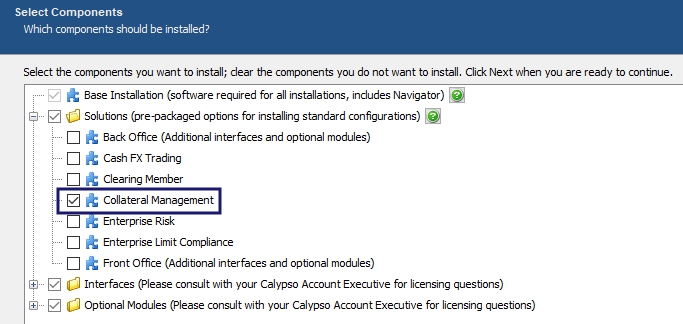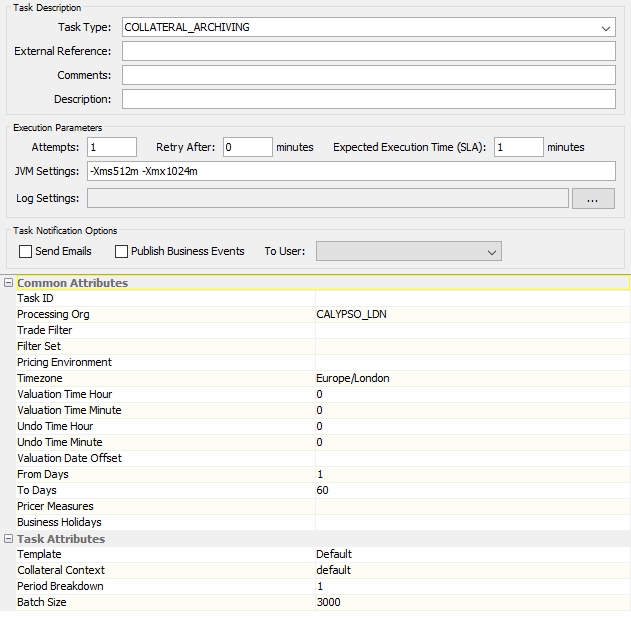Installation Requirements
Below is a description of how to install Calypso's Collateral Management module.
1. Installation
The Collateral module is installed as part of the Calypso Installer when you select Collateral Management in the installer under Solutions(pre-packaged options for installing standard configurations). Please refer to the Calypso Installation Guide for complete details.
When you run Execute SQL as part of your installation, all Collateral files will be already loaded, and any required upgrade process will be performed.

2. Upgrade Notes
The following information is important when upgrading from a previous version of the Collateral module.
| » | When migrating from Calypso version 12 SP3 or earlier, you will need to run the MCC_MIGRATION scheduled task. This scheduled task contains four attributes, Contract Notification Time, Contract Substitution Time, Contract Valuation Time and Dispute Aging. |

This scheduled task must be added to the scheduledTask domain.
| » | The scheduled task MARGIN_CALL is no longer used. For processing, use the COLLATERAL_MANAGEMENT scheduled task and for reporting, the REPORT scheduled task. |
| » | For cover distribution, the COVER_DISTRIBUTION scheduled task functions like the COLLATERAL_MANAGEMENT scheduled task. |
3. Access Permissions
The following access permissions apply to Collateral functions.
Collateral Context
| • | Create/Modify/RemoveCollateralContext - Ability to create, modify and remove Collateral Context configuration |
Collateral Manager
| • | AllowPrice/AllowReprice - Ability to price and reprice in Collateral Manager. A user/group can have neither permission, one or both. |
| • | AllowEditDisputeAgeOffset / AllowEditDirectionalDisputeAgeOffset - Ability to edit the Dispute Age Offset and Directional Dispute Age Offset in Collateral Manager. |
| • | CancelContractAllocations - Permission to use the "Cancel Selected Contracts allocations" and "Cancel all Contracts allocations" options in Collateral Manager. |
| • | RemoveMarginCallEntry - Ability to remove a margin call entry |
Collateral Pool, Clearing Service, Credit Rating Scenario, Liability Group, Concentration Rule, Eligibility Exclusion
| • | Create/Modify/RemoveMarginCallConfig - Ability to create, modify and remove configurations regarding Collateral Pool, Clearing Member Contract Configuration (Cover Distribution), Credit Rating Scenarios, Liability Groups, Concentration Rules and Eligibility Exclusions |
Eligibility Exclusion
| • | EnforceCollateralEligibilityHardWarning - When this permission is set, a hard warning appears when a user attempts to allocate ineligible collateral. This permission needs to be added to the function domain value and set as a Restriction in the Access Permissions window. |
When set, if the Collateral Context warning type is set to HARD, while doing the allocation the hard warning will be displayed and the allocation will not happen. If the Collateral Context warning type is set to SOFT, the soft warning will be displayed. Based on the user selection, that allocation can happen.
Global Credit Rating Configuration
| • | Create/Modify/RemoveGlobalRatingConfiguration - Ability to create, modify and remove global credit rating configurations |
Haircut
| • | Create/Modify/RemoveHaircutRule - Ability to create, modify and remove haircut rules |
Margin Call Configuration
| • | Create/Modify/RemoveCollateralConfig - Ability to create, modify and remove Margin Call Configuration |
| • | AuthorizeCollateralConfig - Ability to authorize margin call config modifications |
Margin Call Credit Rating
| • | Create/Modify/RemoveMarginCallCreditRating - Ability to create, modify and remove margin call credit ratings |
Margin Call Reports
| • | Max.Collateral - The value of this User attribute determines how many margin call entries are loaded in standalone margin call reports such as Margin Call Entries and Margin Call Allocation Entry. |
If the limit is reached and not all of the margin call entries are loaded, the user receives a warning in the Data Server log. There is no pop-up warning in the GUI at this time.
Optimization Configuration
| • | Create/Modify/RemoveOptimizationConfiguration - Ability to create, modify and remove an Optimization Configuration |
Wrong Way Risk Group
| • | Create/Modifiy/RemoveWrongWayRiskGroup - Ability to create, modify and remove wrong way risk groups |
4. Audit
The following classes can be added to the "classAuditMode" domain for recording the corresponding audit information:
BilateralEnry
ClearingService
CollateralConfig
CollateralContext
CollateralExposureContet
ConcentrationRule
EligibilityExclusionConfiguration
ETLJob
ExposureGroupEntry
GlobalRatingConfiguration
InterestStatementReconciliation
LiabilityGroupcontext
MarginCallCreditRatingConfiguration
MarginCallEntry
OptimizationConfiguration
TargetConfiguration
5. Authorization
The following classes can be added to the "classAuthMode" domain for enabling the Authorization mode:
ClearingService
CollateralConfig
CollateralContext
CollateralExposureContet
CollateralSource
ConcentrationRule
EligibilityExclusionConfiguration
ETLJob
ExposureGroupEntry
GlobalRatingConfiguration
LiabilityGroupcontext
MarginCallCreditRatingConfiguration
OptimizationConfiguration
TargetConfiguration
6. Collateral Archiving
Archiving of Collateral entries can be done via a scheduled task called COLLATERAL_ARCHIVING. This scheduled task archives all specified entries with a context, between two given process dates. There is one table name for each table being archived. All tables are named "table_name"_hist.
You need to specify From Days & To Days – Interval for the process date.

| • | Template - Used to specify the scope of contracts for which the collateral objects need to be archived. In the Template Manager of the Collateral Manager, users can specify a collateral static data filter. This feature allows for the archiving of VM contracts, while keeping IM contracts unarchived. |
| • | Collateral Context - archive all entries in selected collateral context |
| • | Batch size – specify the number of entries expected to be archived for each Period Breakdown, for example, Daily, Weekly or Monthly |
| • | Period Breakdown - used to specify an archival frequency between the From Days and To Days |